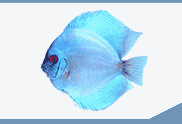 |
 |
The picture of a discus infested with the parasite Chilodonella is used with permission from "Handbook of Fish Diseases" by TFH Publications, Inc.
 Chilodonella is a single cell microscopic parasite that attacks a fish skin and gills. The fish will rub against objects and become inactive. If the gills are affected they will stay near the water surface and gasp for air. Cloudy spots develop on the skin. The skin patches turn white and begin to disintegrate (usually over a couple day period). This opens the door to secondary infections and/or fungus.
Chilodonella is a single cell microscopic parasite that attacks a fish skin and gills. The fish will rub against objects and become inactive. If the gills are affected they will stay near the water surface and gasp for air. Cloudy spots develop on the skin. The skin patches turn white and begin to disintegrate (usually over a couple day period). This opens the door to secondary infections and/or fungus.
This parasite can swim and can attack other fish in the same aquarium. In aquariums with more fish, it is likely to spread rapidly. Poor water conditions also accelerate this disease. It can be introduced with live foods or from ponds or even on a plant.
Treatment is, according to Dieter Untergasser (1989), best achieved with:
- High heat, greater than 86 degrees F. for more than 5 days will kill this parasite (also stated in "Maintaining a Healthy Aquarium" 1985) by Dr. Neville Carrington
- Salt bath (3%= 7.5 tablespoons/gallon according to Dr. Neville Carrington (1985), leave fish in until "roll over," then transfer to clean water) or (second method according to Dr. Carrington is 2.5 tablespoons/gallon for 10 to 15 minutes)
- Salt in the aquarium (helps to prevent secondary infections and to help make the fish more comfortable) at 2 tablespoon/10 gallons
- Acriflavine
- Malachite green
- Clean water conditions
- Antiparasitic medications
- Often times a pH of 5.0 to 6.0 will inhibit parasites, inhibit bacterial infections, and increase slime coat on the fish.
Sources:
- Maintaining a Healthy Aquarium by Dr. Neville Carrington, Salamander Books 1985
- Handbook of Fish Diseases by Dieter Untergasser, TFH Publications, Inc 1989
- http://www.petswarehouse.com/Fishmed5.htm
In this article, malachite green is the preferred treatment. Symptoms of the disease include a "grayish white film" on the fish, possibly swollen gills, and ulcerated areas. It is highly contagious.
- http://www.fishdoc.co.uk/disease/chilodonella.htm
In this link, microscopic photos are shown. Symptoms include labored breathing, flashing and rubbing, skin cloudiness, loss of appetite, and lethargy. They may lie on the bottom with clamped fins. One treatment of one of the following is usually sufficient. PP, Formalin, malachite, copper or salt.
- http://www.aquaworldnet.com/dbws/symtreat.shtml
At this link treatments include high heat, copper, formalin+malachite green, treatment should go for a week or more.
- http://www.fishyfarmacy.com/Diseases/Skin.html
It states here that often this disease can only be seen from a head on view. Treatments include Metronidazole, Malachite green + formaldehyde
- http://www.aquarium.net/0297/0297_2.shtml
In this article the life cycle of the parasite is discussed. Treatments include acriflavine, methylene blue, or formaldehyde. It claims that temperature will not affect this parasite.
|
 |




 Chilodonella is a single cell microscopic parasite that attacks a fish skin and gills. The fish will rub against objects and become inactive. If the gills are affected they will stay near the water surface and gasp for air. Cloudy spots develop on the skin. The skin patches turn white and begin to disintegrate (usually over a couple day period). This opens the door to secondary infections and/or fungus.
Chilodonella is a single cell microscopic parasite that attacks a fish skin and gills. The fish will rub against objects and become inactive. If the gills are affected they will stay near the water surface and gasp for air. Cloudy spots develop on the skin. The skin patches turn white and begin to disintegrate (usually over a couple day period). This opens the door to secondary infections and/or fungus.
